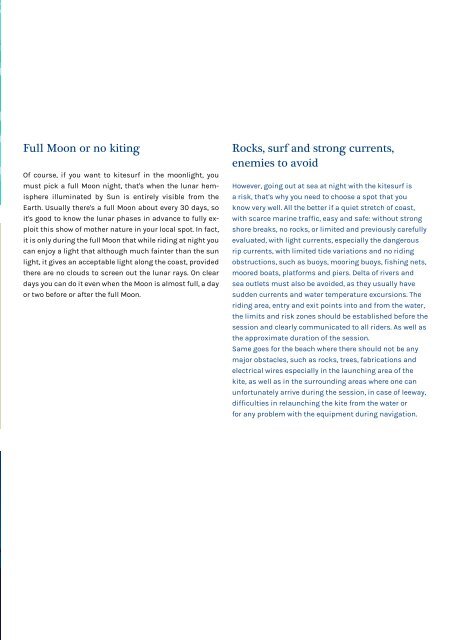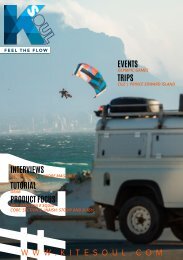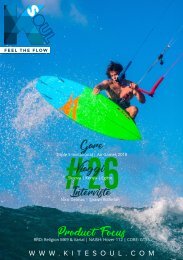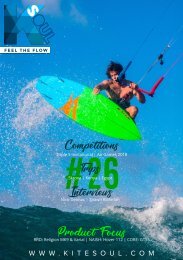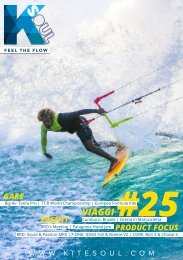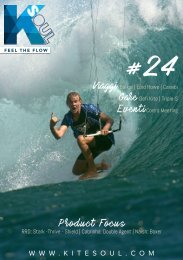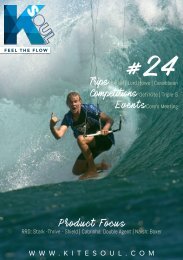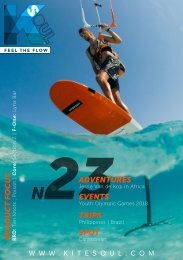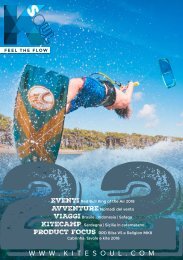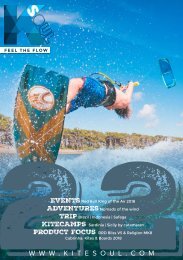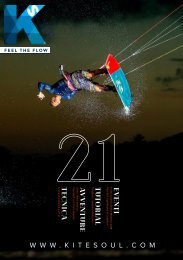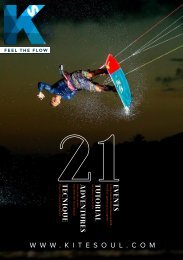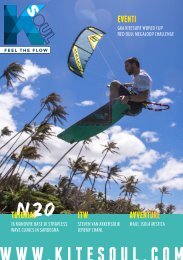Kitesoul Magazine #25 International Edition
In this issue: TwinTip Racing: Florian Gruber and Sofia Toma- soni, Airton claims his fourth win in the GKA WORLD TOUR, Jesse Richman flies higher at the inaugural Air Games event, RRD international meeting, Roberto Ricci: kitesurfing was originally about kitesurfing on waves, Guy Bridge and Daniela Moroz 2018 Formula Kite Euro champs, Patagonia Hood Jam, and much more.
In this issue: TwinTip Racing: Florian Gruber and Sofia Toma- soni, Airton claims his fourth win in the GKA WORLD TOUR, Jesse Richman flies higher at the inaugural Air Games event, RRD international meeting, Roberto Ricci: kitesurfing was originally about kitesurfing on waves, Guy Bridge and Daniela Moroz 2018 Formula Kite Euro champs, Patagonia Hood Jam, and much more.
You also want an ePaper? Increase the reach of your titles
YUMPU automatically turns print PDFs into web optimized ePapers that Google loves.
Full Moon or no kiting<br />
Of course, if you want to kitesurf in the moonlight, you<br />
must pick a full Moon night, that's when the lunar hemisphere<br />
illuminated by Sun is entirely visible from the<br />
Earth. Usually there's a full Moon about every 30 days, so<br />
it's good to know the lunar phases in advance to fully exploit<br />
this show of mother nature in your local spot. In fact,<br />
it is only during the full Moon that while riding at night you<br />
can enjoy a light that although much fainter than the sun<br />
light, it gives an acceptable light along the coast, provided<br />
there are no clouds to screen out the lunar rays. On clear<br />
days you can do it even when the Moon is almost full, a day<br />
or two before or after the full Moon.<br />
Rocks, surf and strong currents,<br />
enemies to avoid<br />
However, going out at sea at night with the kitesurf is<br />
a risk, that's why you need to choose a spot that you<br />
know very well. All the better if a quiet stretch of coast,<br />
with scarce marine traffic, easy and safe: without strong<br />
shore breaks, no rocks, or limited and previously carefully<br />
evaluated, with light currents, especially the dangerous<br />
rip currents, with limited tide variations and no riding<br />
obstructions, such as buoys, mooring buoys, fishing nets,<br />
moored boats, platforms and piers. Delta of rivers and<br />
sea outlets must also be avoided, as they usually have<br />
sudden currents and water temperature excursions. The<br />
riding area, entry and exit points into and from the water,<br />
the limits and risk zones should be established before the<br />
session and clearly communicated to all riders. As well as<br />
the approximate duration of the session.<br />
Same goes for the beach where there should not be any<br />
major obstacles, such as rocks, trees, fabrications and<br />
electrical wires especially in the launching area of the<br />
kite, as well as in the surrounding areas where one can<br />
unfortunately arrive during the session, in case of leeway,<br />
difficulties in relaunching the kite from the water or<br />
for any problem with the equipment during navigation.<br />
07


